AC. A Rare Look Inside Victorian Homes from the 1800s: Life, Elegance, and Everyday Charm
Victorian homes from the 1800s have long fascinated historians, antique collectors, and anyone with an eye for classic design. Their ornate architecture, richly decorated interiors, and detailed furnishings offer a glimpse into a bygone era—when homes were not just places to live, but showcases of culture, social class, and everyday life.
Thanks to a remarkable collection of historical photographs from the late 19th century, we can explore what life was really like behind the lace curtains and carved woodwork. These rare images, many captured between 1865 and 1900, open a visual window into Victorian living rooms, parlors, dining areas, and family spaces—each one telling its own quiet story.
Let’s take a look at these rare photographs and uncover what they reveal about daily life in Victorian homes.
The Victorian Dining Room, Circa 1890

In this beautifully preserved photo from the 1890s, we see a formal dining room typical of upper-middle-class Victorian homes. The room is rich with details: an elaborate sideboard, a lace tablecloth, a glass-fronted china cabinet, and even a fireplace for warmth. It’s not hard to imagine a multi-course meal being served here, complete with silver flatware and polite conversation. Victorian dining rooms were often the most elaborately furnished spaces in the home, intended to impress visitors and host social gatherings.
Glimpses of Everyday Life: “Interieur” by Lady Frances Jocelyn (1865)
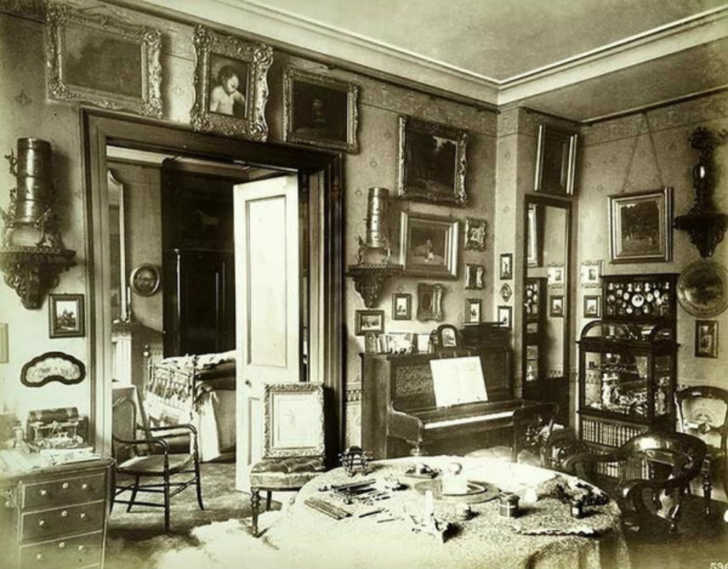
One of the earliest and most intimate glimpses into Victorian domestic life comes from a photograph taken in 1865 by Lady Frances Jocelyn. Simply titled “Interieur,” the image shows a woman seated by the window, surrounded by delicate furnishings and natural light. This image reminds us that even amid the grandeur, Victorian homes were deeply personal spaces. The softness of the scene contrasts beautifully with the era’s often stiff reputation.
A Belgian Summer Lounge, 1895
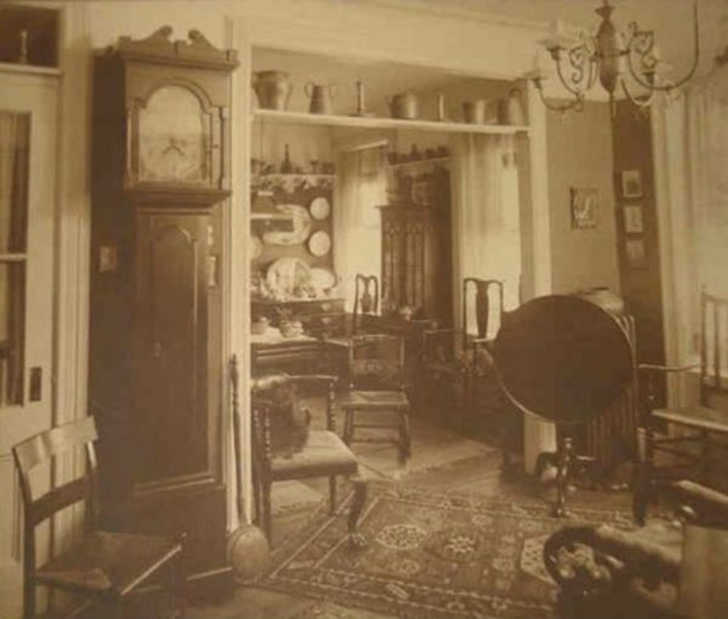
In a photograph by Marcel Vanderkindere taken in Belgium in 1895, a breezy summer lounge invites comfort and calm. The room is filled with woven chairs, soft fabrics, and open windows—creating a perfect place for reading or afternoon tea. A cozy rocking chair placed near the center of the room adds a human touch, suggesting a slower pace of life and a deep appreciation for comfort and aesthetics.
The Warmth of a 19th Century Parlor
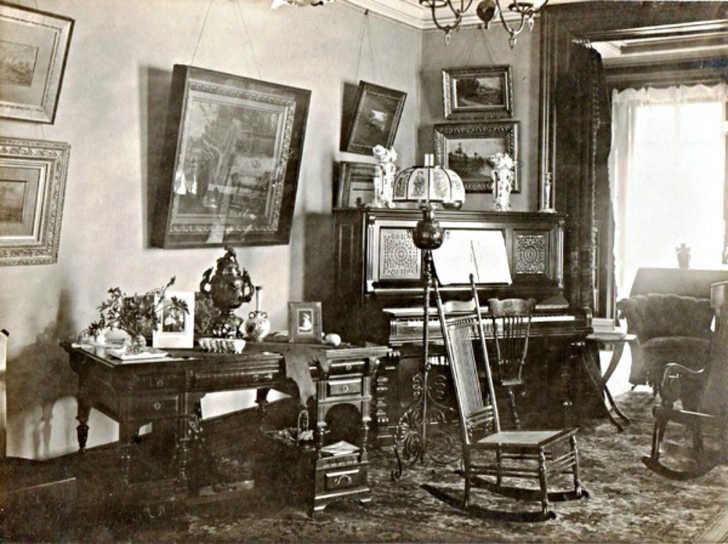
Many Victorian homes featured a parlor or sitting room, used for hosting guests and displaying family status through carefully chosen furnishings. In one preserved image, a modest 1880s parlor includes a mounted deer head, a fur rug, and a spinning wheel—evidence of both affluence and practicality. These details indicate that the family likely participated in hunting and domestic weaving, blending luxury with traditional living skills.
High-Ceilinged Elegance in Cortland, New York
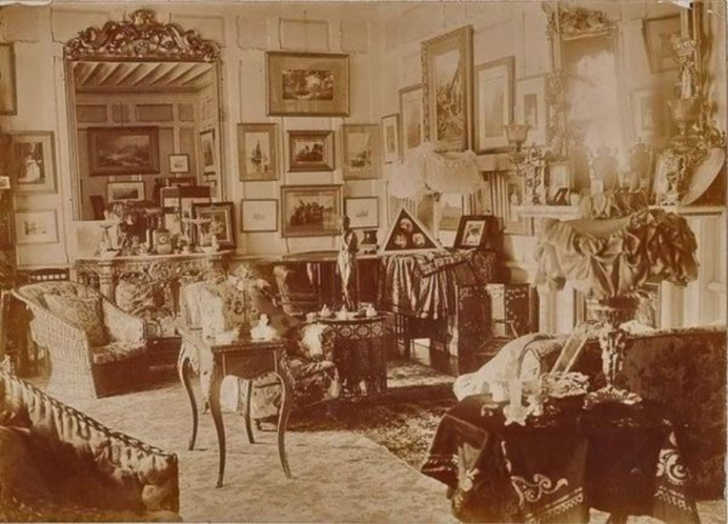
An extraordinary photo from Cortland, New York (1890s) showcases a tall-ceilinged Victorian parlor, complete with velvet curtains, an oversized fireplace, and decorative plaster molding. The scale of the room suggests a well-off family, though such high ceilings would have required a roaring fire to keep warm during northeastern winters. The room’s grandeur is balanced by carefully placed furniture—armchairs, writing desks, and reading lamps—all arranged with purpose.
A Middle-Class Victorian Parlor
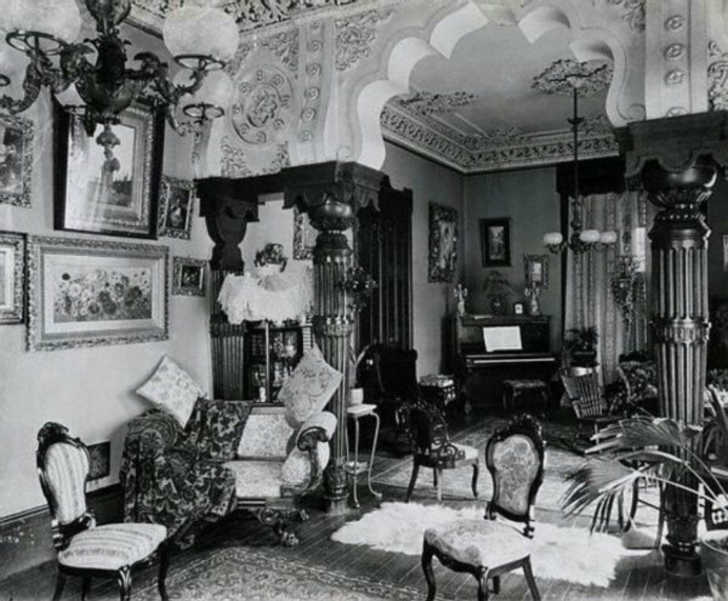
Not all Victorian homes belonged to the wealthy. One photograph features a modest but beautiful middle-class sitting room. While not as expansive as an upper-class home, the room is filled with charm: polished wooden furniture, floral wallpaper, and modest art on the walls. It’s a reminder that many Victorian families, regardless of income, took pride in their homes and embraced decorative living.
A Glimpse into Upper-Class Luxury (1885)
An image from VictorianChildren.org (circa 1885) captures the splendor of a high-society Victorian home. Notice the oversized palm plant, detailed crown molding, and abundance of upholstered chairs. Everything about the space—its symmetry, decoration, and lighting—was meant to impress. This home likely belonged to a family of significant wealth and social standing.
Comfortable Clutter and Decorative Warmth
Victorian parlors were often filled with items that today might be considered “clutter”—but in reality, they reflected an intentional design philosophy. Photographs from the era show rooms adorned with multiple chairs, framed photographs, piano benches, and small tables for tea or work. What may look crowded by today’s minimalist standards actually offered flexibility for entertaining, relaxing, or reading by the fire.
The Multipurpose Parlor
Many parlors served double duty. In one remarkable image, the parlor also functioned as a workroom, complete with a writing desk and a spinning wheel. The walls are covered in photographs and paintings, many likely of family members and personal memories. These details show how Victorians cherished their loved ones and surrounded themselves with stories of the past.
Eldon House: An Icon of Victorian Opulence
One of the most beautiful preserved Victorian interiors belongs to the Eldon House in Ontario, Canada. A photograph of its lush parlor, courtesy of Western Libraries, shows Persian carpets, towering houseplants, and finely carved wooden furniture. The Eldon House is now a museum, offering modern visitors a rare opportunity to step into an authentic 19th-century domestic space.
The Importance of Chairs in Victorian Homes
One consistent feature across Victorian interiors is the abundance of chairs. Chairs were not only practical but also symbolic. They communicated hospitality, readiness for guests, and social warmth. Whether arranged in circles for conversation or placed beside a piano for musical evenings, chairs were integral to the rhythm of Victorian life. As a saying from the time goes: “Y’all have chairs here!”—a testament to welcoming company.
Victorian Homes as Storytellers
These rare interior photos from the 1800s do more than show us furniture and wallpaper—they tell us stories. They reveal how people lived, worked, and connected. From luxurious drawing rooms to modest parlors, every space reflects an era of craftsmanship, pride, and attention to detail.
The presence of items like spinning wheels, hunting trophies, oil lamps, and musical instruments points to a culture that valued self-sufficiency, tradition, and the arts. These homes were more than shelters—they were expressions of identity and lifestyle.
Why We Love Looking Inside Victorian Homes
For collectors, historians, and lovers of the past, Victorian homes offer a comforting and nostalgic look at a slower, more deliberate way of life. While some may view their ornate designs as outdated or overly cluttered, many today see them as rich with character and timeless beauty.
Photographs from the 1800s help preserve this charm, capturing moments that are both intimate and iconic. They allow us to appreciate the artistry, the stories, and the daily routines of those who came before us.
Final Thoughts
From croquet lawns to cozy parlors, from velvet drapes to spinning wheels, Victorian homes remain a source of fascination. These interiors offer more than style—they offer substance, history, and connection.
As we look back at these carefully curated images from the 1800s, we’re reminded that behind every photograph is a lived experience, a memory, and a piece of the human story.













